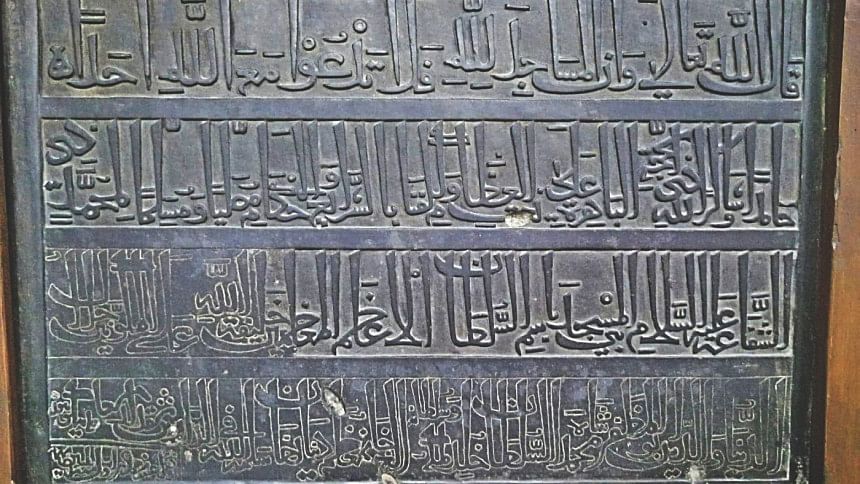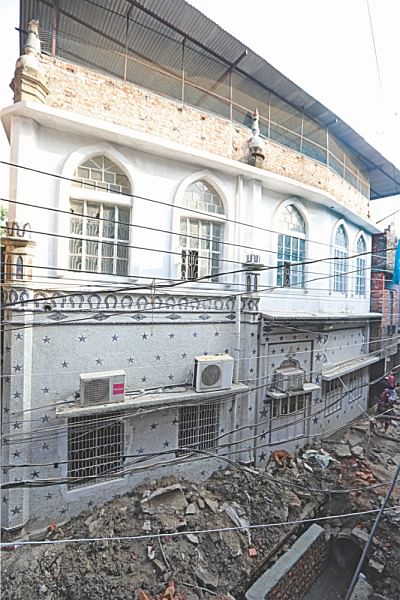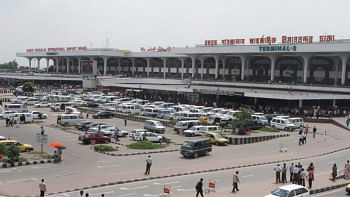Manda Masjid: 6-century old inscription remains, structure doesn’t


From the Sultanate period, Dhaka witnessed many mosques built on its land, and that tradition was continued with utmost conviction -- to make the city full of places to pray -- throughout the Mughal era. They were definitely successful as Dhaka is commonly known as a “city of mosques”.
Today, the Sultans and Mughal administrators are no more. Only their vestiges, in the form of these structures, remain -- reminding us of a time long gone. Consequently, the mosques that are still standing have become prime attractions for locals as well as tourists.
Visiting these ancient structures, one may wonder, which is the oldest mosque in Dhaka?
“Binat Bibi Mosque”, constructed in 1454 at Old Dhaka’s Narinda, is widely referred to as the oldest mosque that is still standing. It was built during the sultanate of Nasiruddin Mahmud Shah I.
However, decades ago, a tablet was discovered with inscriptions referring to an elusive mosque built even before the 1450s. According to the inscriptions, “Manda Masjid” was built in 1433.
Dr Abdul Karim’s book, “Mughal Rajdhani Dhaka”, published in 1994, says Manda Masjid was built onshore of the Dhalai river, one of the main waterways during Sultanate and Mughal eras.
Habiba Khatun, former professor of Islamic History and Culture Department at Dhaka University (DU), gave account of this mosque in her doctoral thesis. She had visited it in 1982 and after observing Manda Masjid’s architecture, she stated that it belongs to the Sultanate period, according to an earlier news report.
This correspondent, however, could not verify the thesis content as DU authority failed to provide a copy. Surprisingly, the Department of Archaeology (Dhaka) knows nothing about this mosque. “It is not included in our archaeological list,” said Rakhi Roy, regional director (Dhaka) of the department.
A quest for the mosque led to what is presently known as “Nandu Bepary’r Masjid”, situated on Joda Masjid Lane in Manda area of Dhaka’s Mugda.

Was this the original Manda Masjid? Why was the name which the mosque went by for generations suddenly change? Md Nur-Hossen Bepary, a descendant of Nandu Bepary, narrated the long history of the mosque.
“Over 300 years ago, our ancestor Abu Bepary arrived in Manda along with his father and started living here permanently. Along the way, Abu’s father became the Imam of the mosque,” Nur-Hossen said.
“After his father’s death, Abu took charge of the mosque,” he said. “During that period, the mosque started to become dilapidated. Abu’s son Nandu, however, was a rich businessman, so he repaired it. From then on, locals started calling it ‘Nandu Bepary’r Masjid’,” he added.
Sadly, as the story went on, it became evident that the nearly 600-year-old Manda Masjid which used to stand there was lost in time. Matiur Rahman Bepary, another descendant, revealed, “Years ago, the mosque was irreparably damaged. After that, it was rebuilt following the trending design of the time, and in 2009, it was further modernised.”
Every historic feature of the structure -- its antique design and wall decorations made of valuable stones, its dome, and even its name – has been erased. There is no way one can infer that a centuries-old mosque used to stand there going by the current structure.
Only one piece of evidence of its existence remains: the tablet with the inscription, which is still conserved at the National Museum. The authorities recovered the tablet from Manda before 1965, when Dhaka Museum was in Nimtoli.
The black basalt tablet, which contains four lines in Arabic, mentions Sultan Jalal al-Din Muhammad Shah. Jalal al-Din was a Sultan of Bengal in the 15th century. He ruled for 16 years in two periods -- from 1415 to 1416, and then from 1418 to 1433.
The first two lines of the inscription praise God and his messenger. “The mosque was built in the name of the sultan,” reads the third line.
The final line reads, “Muzaffar Muhammad Shah al-Sultan; may Allah perpetuate his kingdom and sovereignty. [Built by] Ulug Khan Muazzam Dinar Khan…Shiqdar of Affairs Nayk Muhammad copied [it] on Jumad-al-Awwal, 836 AH (January 3, 1433).”
Bengal grew in wealth and population during Jalal’s reign. He had commissioned construction of many mosques and buildings, combining Bengali and Islamic architecture.
He died in 1433 and was buried at Eklakhi Mausoleum in Pandua of India’s West Bengal. The year of his death coinciding with that of the structure’s construction indicates that Manda Masjid was possibly built to mark his demise.
As the centuries passed by, Jalal’s kingdom was gone, his structures demolished, and his name gradually became obscure. Only some vestiges, like the tablet and his tomb, are left to remind us of a ruler who was once considered to be the greatest of all greats.

 For all latest news, follow The Daily Star's Google News channel.
For all latest news, follow The Daily Star's Google News channel. 



Comments